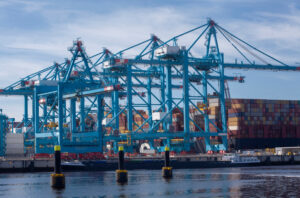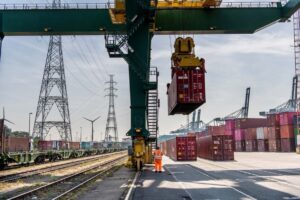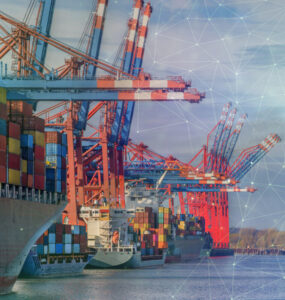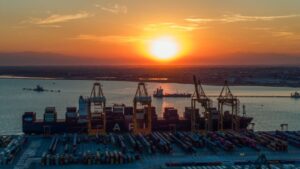Despite the pandemic, shipping and port stakeholders are continuing to invest in emerging autonomous, decarbonised and simulated technologies.
Observers in the industry were concerned that COVID-19 would scale back public and private investment in emerging technologies. But the industry is instead seeing the opposite, with investment in zero-emission maritime, autonomous vessel management, and digitalisation of ports.
“I think one of the positive developments I see at the moment is that despite COVID-19, or maybe because it has been stimulated by COVID-19, is that shipping is taking steps to be more sustainable is becoming more concrete and urgent,” said Bas Buchner, President of the Marine Research Institute Netherlands (MARIN).
Buchner added that ports are also making investments in sustainability through bunkering facilities, and in developments in autonomous shipping and digitalisation of port complexes.
MARIN, an independent research institute based in Wageningen, utilises its testing facilities to assist clients in new technologies: ranging from bridge simulation to autonomous vessel testing and piloting.
Ahead of MARIN’s session at Smart Digital Ports of the Future Spring 2021, Buchner outlined the status of emerging priorities in technologies facing smart ports in the years ahead.
Autonomy: The port-vessel relationship
On autonomous shipping, Buchner said client ports such as the Port of Rotterdam, Port of Amsterdam, and the Port of Antwerp are working hard on readying their ports capable of handling unmanned and partially-manned vessels in the coming years.
“We are seeing new types of developments for vessel traffic management, including autonomous ships piloting at a distance,” Buchner said.
“But what you also see is some examples of inland ships which are partly autonomous. You see some short-sea shipping vessels with possibilities for autonomous sailing, but it’s not a major part of the business. And most of it is still small ships for inspection. So we should not exaggerate the number of ships that are becoming autonomous.”
Despite autonomous shipping still being in a fledgling state in major European ports, smaller and intermediate ports should still invest in Vessel-to-Everything (V2X) infrastructure (such as sensors and shared data measuring devices) between ship and shore.
“I think definitely you should also involve the smaller ports and there should be a complete ecosystem along all the ports,” he said. “Otherwise autonomous shipping is of no use, because you are safe in one port, but unsafe in another port.”
Buchner added that autonomous investment strategies from smaller ports should key in on vessel traffic management and strong remote piloting systems to forward-plan for a more efficient shipping process.
Offshore and flexi-ports
In 2017 MARIN unveiled the concept of floating multifunctional ‘mega islands’, comprising of floating triangles connected flexibly to create a floating island capable of reaching up to five kilometres in size.
Buchner notes that dynamic and adjustable ports can provide a range of benefits from remote fuel bunkering to providing a resources hub for emerging and newly developing ports.
“Flexibility is a hugely important thing,” said Buchner. “If you want to develop a port within Africa or South America, and you want to bring in or take out resources from land, then you have to start to cut trees or use land-based infrastructure.
“Whereas in a floating structure situation, you can start to build an initial offloading point along the coast, and increase or decrease your floating port as you need.”
Offshore ports can also unlock the long-lamented challenge in shipping of bunkering for vessel operators: large ships are often disadvantaged by having to travel into major ports to find bunkering points – an issue flexi-ports could solve through renewable fuel sources.
“If your offshore port has a wind farm, you can produce hydrogen locally and the ship can start to bunker there,” he said. “So it opens a lot of possibilities for temporary flexible flow port-like solutions – and that’s what we like about it.”
A positive outlook on simulation
MARIN is developing the Seven Oceans Simulator Centre, equipped with moving, large-scale, and multi-purpose simulator training for vessels.
Whilst Seven Oceans is primarily for ship piloting, the use of simulation is a rapidly-growing industry in ports also – however the significant investment required currently could prevent ports with fewer resources from harnessing the technology.
Buchner believes positivity around simulation will continue to grow. Prices will fall and competition will grow for Augmented Reality (AR) and Virtual Reality (VR) solutions and equipment offered to ports, and some ports may not need a centre as comprehensive as Seven Oceans, choosing a 3D goggle instead.
“I think in the future, smaller ports will benefit from VR goggles when the costs go down,” Buchner commented.
“We’re seeing that simulators make operations in ports safer. Yes, it is a few hundred thousand Euros now. But then if that prevents one accident, including the training of the use of equipment in ports, it is worth the investment.”









